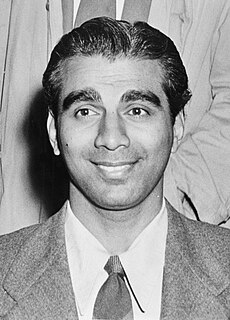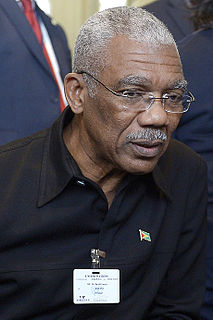
The politics of Guyana takes place in a framework of a Parliamentary representative democratic republic, whereby the President of Guyana is the head of government and of a multi-party system. Executive power is exercised by the President, advised by a cabinet. Legislative power is vested in both the President and the National Assembly of Guyana. The judiciary is independent of the executive and the legislature.
The history of Guyana begins about 35,000 years ago with the arrival of humans coming from Eurasia. These migrants became the Carib and Arawak tribes, who met Alonso de Ojeda's first expedition from Spain in 1499 at the Essequibo River. In the ensuing colonial era, Guyana's government was defined by the successive policies of Spanish, French, Dutch, and British settlers.

HE Cheddi Berret Jagan was a Guyanese politician who was first elected Chief Minister in 1953 and later Premier of British Guiana from 1961 to 1964. He later served as President of Guyana from 1992 to 1997. Jagan is widely regarded in Guyana as the Father of the Nation. In 1953, he became the first person of Indian descent to be a head of government outside of South Asia.

Bharrat Jagdeo is a Guyanese politician who has been serving as Vice President of Guyana since 2020, in the administration of President Irfaan Ali. He had previously also held the office from 1997 until 1999, during the presidency of Janet Jagan. Jagdeo subsequently served as the President of Guyana from 11 August 1999 to 3 December 2011. He also holds a number of global leadership positions in the areas of sustainable development, green growth and climate change.

Samuel Archibald Anthony Hinds is a Guyanese politician who was Prime Minister of Guyana almost continuously from 1992 to 2015. He also briefly served as President of Guyana in 1997. He was awarded Guyana's highest national award, the Order of Excellence (O.E.) in 2011.

The flag of Guyana, known as The Golden Arrowhead, has been the national flag of Guyana since May 1966 when the country became independent from the United Kingdom. It was designed by Whitney Smith, an American vexillologist. The proportions of the national flag are 3:5. The colours are symbolic, with red for zeal and dynamism, gold for mineral wealth, green for agriculture and forests, black for endurance, and white for rivers and water.

Janet Rosenberg Jagan was a U.S.-born Guyanese politician who served as the President of Guyana, serving from December 19, 1997, to August 11, 1999. She was the first female President of Guyana. She previously served as the first female Prime Minister of Guyana from March 17, 1997, to December 19, 1997. The wife of Cheddi Jagan, whom she succeeded as president, she was awarded Guyana's highest national award, the Order of Excellence, in 1993, and the UNESCO Mahatma Gandhi Gold Medal for Women's Rights in 1998.

Linden Forbes Sampson Burnham was a Guyanese politician and the leader of the Co-operative Republic of Guyana from 1964 until his death. He served as Prime Minister from 1964 to 1980 and then as its first Executive President from 1980 to 1985. He is often regarded as a strongman who embraced his own version of communism. Throughout his presidency, he encouraged Guyanese to produce and export more local goods, especially through the use of state-run corporations and agricultural cooperatives. Despite being widely regarded as one of the principal architects of the postcolonial Guyanese state, his presidency was nonetheless marred by repeated accusations of Afro-supremacy, state-sanctioned violence, economic collapse, electoral fraud, and corruption.

Elections in Guyana take place within the framework of a multi-party representative democracy and a presidential system. The National Assembly is directly elected, with the nominee of the party or alliance that receives the most votes becoming President.

Donald Rabindranauth Ramotar is a Guyanese politician who was President of Guyana from 2011 to 2015. He was also the General Secretary of the People's Progressive Party (PPP) from 1997 to 2013.

The People's National Congress–Reform is a social-democratic and democratic socialist political party in Guyana led by David A. Granger. The party currently holds 31 of the 65 seats in the National Assembly. In Guyana's ethnically divided political landscape, the PNCR is supported primarily by Afro-Guyanese people.

David Arthur Granger is a Guyanese politician and retired military officer who served as the 9th President of Guyana from May 2015 to August 2020. He served for a time as Commander of the Guyana Defence Force and subsequently as National Security Adviser from 1990 to 1992. He was Leader of the Opposition in the National Assembly of Guyana from 2012 to 2015.
Geoffrey da Silva is a politician and administrator in Guyana. He was the Guyanese Minister of Trade, Tourism and Industry from 1999 to 2001 and later served as head of Guyana Investment (Go-Invest).

General elections were held in Guyana on 28 November 2011. The result was a victory for the People's Progressive Party, which won 32 of the 65 seats. Thus even though the combined parliamentary opposition, consisting of the A Partnership for National Unity coalition (APNU) and the Alliance for Change (AFC), managed to secure an absolute majority of 33 seats, as they had not run as a single list it was Donald Ramotar of the PPP who assumed the presidency, and not David A. Granger of the PNC.

Early general elections were held in Guyana on 11 May 2015, alongside regional elections as a result of President Donald Ramotar proroguing the National Assembly. The result was a victory for the APNU–Alliance for Change alliance, which won 33 of the 65 seats in the National Assembly. Following the elections, APNU leader David A. Granger was sworn in as president on 16 May 2015.

Snap general elections were held in Guyana on 2 March 2020. They were called early after the government of President David A. Granger lost a vote of no confidence by a margin of 33–32 on 21 December 2018, the government having held a one-seat majority since the 2015 elections. However, one of its own MPs, Charrandas Persaud of the Alliance for Change (AFC), voted with the opposition. Granger announced on 25 September 2019 that the elections would be held on 2 March 2020.
Isahak Basir CCH was a Guyanese historian who was a member of the National Assembly of Guyana from 1977 to 1991. Basir was nicknamed "Uncle Tabrak" and was of Indian descent.
Asgar Ally is a former Guyanese politician. He served as Minister of Finance from 1992 to 1995.



















